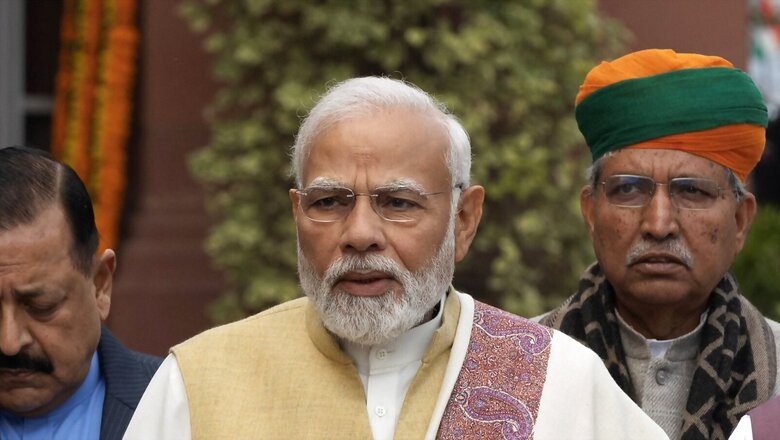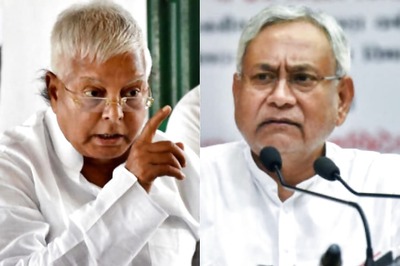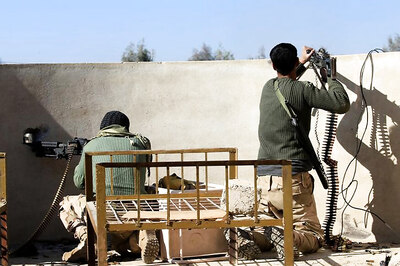
views
Today, when Finance Minister Nirmala Sitharaman, clad in a bright red saree, stood up in the Lok Sabha at 1100 hours to present her fifth straight Union Budget, also the last full Budget of the Modi government 2.0 and the first Budget of Amrit Kaal, she faced the dilemma of a lifetime. Her litany of woes was humungous with the compelling competing priorities: topsy-turvy uncertain global geopolitical and new-normal subdued economic scenario; a slowing domestic economy despite growing faster than other major economies; the headline inflation beyond the comfort zone with uncertain prognosis; and finally, the political compulsion of doing the funambulist rope-dancing in the surcharged atmosphere of the political slugfest with nine states going to hustings in 2023 (Hindi heartland states — Rajasthan, Chhattisgarh, Madhya Pradesh; Southern states Telangana and Karnataka; and four Northeast states — Tripura, Meghalaya, Nagaland and Mizoram).
And with the Budget being the last full Budget before the country goes in fast-forward mode to the 2024 Lok Sabha elections, no one would have faulted ‘Modinomics’, had Sitharaman played to the gallery and showered populist goodies to the electorate.
But it was not to be.
Instead of proving to be an election year, FM Sitharaman opted to present a forward-looking, growth-oriented Budget, ticking all the key right boxes, right consolidation of the economy with a targeted march towards fiscal consolidation, a big boost to the infrastructure-led capital expenditure and her framework of the ‘Saptarishi’ priorities to propel growth to a higher level on way to achieve the status of a developed economy by 2047, at the end of Amrit Kaal when India celebrates 100 years of the independence.
Budget FY2024 takes off from where the Budget FY2023 left and builds the new building blocks around the central vision for Amrit Kaal India@100: the opportunities for citizens with a focus on the youth; the growth and job creation; a strong and stable macro-economic environment — all tailormade to the solitary aim of propelling the country to a higher level of development and providing the much-needed growth impetuous.
The Budget speech rightly began with notable achievements: despite the turbulence, the economy is growing at 7 percent per annum, which is the highest among all the major economies. It is becoming the fifth-largest economy despite the massive slowdown globally caused by Covid-19 and the Russia-Ukraine war. And it makes the correct prognosis of the Indian economy heading towards a brighter future.
Equally significant to note is that the country, during the Covid pandemic, ensured no one went hungry by providing free food grains to over 80 crore people for 28 months. And it also makes the right pitch of continuing a bold measure to ensure food and nutritional security, from 1 January 2023, a scheme to supply free food grain to all Antyodaya and priority households for the next year, under PM Garib Kalyan Anna Yojana (PMGKAY). Importantly, the entire expenditure of about Rs 2 lakh crore will be borne by the Central government.
The following separated this year’s Budget from populism and made it special-
- Focus on consolidation of the economy- The fiscal deficit from 9.2 percent in the Covid-ridden year of 2020-21 was steadily brought down to 6.7 percent (2021-22) and 6.4 percent (2022-23) and is pegged at 5.9 percent for 2023-24, on way to go down below 4.5 percent in FY25-26. In tandem, the primary deficit also has shown a healthy reduction trend from 5.8 percent in FY21, to 4.4 percent in FY22, to 2.9 percent in FY23 and projected at 1.7 percent in FY24. Indubitably, the country is on the right path of fiscal consolidation.
- Singular focus on capital expenditure- The second big picture that emerges from the Budget is that of singular focus on capital expenditure (CapEx) which, at Rs 10,00,961 crore, is 33 percent more from the previous year, and roughly double that of FY2022. If one adds the grants in aid being given in the form of a 50-year interest-free loan to states for CapEx of Rs 3,69,909 crore, the total capital expenditure outlay for FY24 is a whopping 13,70,949 crore. And what a mammoth increase it has been — nine times of total CapEx outlay in FY2014.
- Saptarishi (the 7 priorities): The key building blocks of the Budget is centered around Saptarishi- its 7 pillars of priorities namely- inclusive development, infrastructure and investment, unleashing the potential, green growth, financial sector empowerment, harnessing youth power and reaching the last mile. The remaining pages of the speech of the finance minister, instead of focusing on semantics, elaborate in sufficient detail the focus on 7 pillars of priorities.
- Income tax reforms and reliefs: A much-needed relief for honest income taxpayers was a work in progress and its importance in no way gets diminished by the fact that it has arrived in the election year. Five different types of income tax reliefs announced along with other methods of rationalisation, simplification and decriminalisation of the direct tax regime, will further improve compliance, broaden the tax base and will build the confidence of honest taxpayers-both individuals and corporate. There are welcome reliefs, both at the bottom of the pyramid and the highest end of the tax slabs. Income tax reforms — the way they have been built — will encourage taxpayers to move to the new taxation regime that is transparent.
The Budget rightly puts emphasis on envisioning a prosperous and inclusive India, in which the fruit of development reaches all regions and citizens, providing them with a better quality of living and a life of dignity, especially the country’s youth and marginalised sections- women, farmers, OBCs, Scheduled Castes and Scheduled Tribes. The Budget rightly notes that in nine years, since 2014, the per capita income has more than doubled to 1.97 lakhs. But it is miles to go, even if the country has to attain the level of middle-income countries in the medium term and to achieve that, the country has to substantially up the ante of inclusive growth, innovation, employment generation and governance front and a metamorphosis on social indicator development.
The scale of targeted achievements of the government on many fronts have indeed been noteworthy: one, 11.7 crore household toilets under Swachh Bharat Mission; two, 9.6 crore LPG connections under Ujjawala; three, 220 crore Covid vaccination of 102 crore persons; four, 47.8 crore PM Jan Dhan bank accounts; five, insurance cover for 44.6 crore persons under PM Suraksha Bima and PM Jeevan Jyoti Yojana and six, cash transfer of Rs 2.2 lakh crore to over 11.4 crore farmers under PM Kisan Samman Nidhi. And many more. But a lot remains to be done, and it is time for fastening the seat belt.
Towards this end, here is what the government intends to achieve:
- Technology-driven and knowledge-based economy with strong public finances and a robust financial sector. And the Budget’s plan to actualise is critical focus on Jan Bhagidari through Sabka Saath Sabka Prayas.
- To achieve the above, the Budget provides the directional and aspirational agenda of: first, facilitating ample opportunities for citizens, especially the youth, to fulfil their aspirations; second, providing a strong impetus to growth and job creation; and third, strengthening macro-economic stability.
- As explained, turbocharging the economy increased the capital investment outlay steeply, third year in a row, taking it beyond Rs 10 lakh crore to 3.3 percent of GDP.
- Fast-track the Central government’s efforts to enhance growth potential and job creation, crowd-in private investments, and provide a cushion against global headwinds.
- To incentivise the state government for much higher investment in CapEx through substantial targeted grants in aid, in the form of a 50-year interest-free loan.
- Apart from the massive infrastructure investment by Central and state governments, substantially enhancing opportunities for private investment using the newly established Infrastructure Finance Secretariat to jumpstart higher levels of private investment in infrastructure, including railways, roads, urban infrastructure and power, which are currently predominantly dependent on public resources.
- The Budget provides clear direction to states and cities encouraging them to move towards sustainable cities by undertaking urban planning reforms and actions to transform cities into ‘sustainable cities of tomorrow’. This is critical because, by 2030, more than 60 crore Indians will be living in cities and towns. And achieving the desired results will entail efficient use of land resources, adequate resources for urban infrastructure, transit-oriented development, enhanced availability and affordability of urban land, and opportunities for all, including the have-nots for those at the bottom of the pyramid, the urban poor. However, the caveat is that this vision of the Budget is not backed with a sufficient enhancement of budgetary outlay for the urban sector. Also, the Budget focus on property tax governance reforms and ring-fencing user charges on urban infrastructure is a welcome move, but given the governance structure and finances of urban local bodies in tatters, the scheme of municipal local bonds is likely to be a non-starter. What’s critically needed in its place is the progressive ‘Polluters Pay Taxation.’ However, the move to put in place the Urban Infrastructure Development Fund (UIDF) to create urban infrastructure in Tier 2 and Tier 3 cities is a welcome move, though it will need a lot more than providing Rs 10,000 crore per annum to make it a potent vehicle of urban rejuvenation.
- The focus on urban sanitation is welcome. Swachh 1.0 and 2.0 have not borne the fruits as desired. To make the program of 100 percent mechanical desludging of septic tanks and sewers to transition from manhole to machine-hole mode will need all the might of Central, state and city governments to succeed. The same is true for the programs pertaining to the ‘circular economy’ of solid wage management reforms. There is an implementation bug facing the nation when it comes to urban sanitation.
- The government’s focus on ‘Good Governance’ as central to the nation’s progress is laudable, and so are the schemes for capacity building. But these are long-term measures and the important thing is that the step is being taken in the right direction.
- The country’s dogged focus on enhancing the ease of doing business has given desired results. But the journey is akin to the Sisyphean curse, mere reduction of compliance by 39,000 and decriminalisation of 3,400 legal provisions are not enough. What is needed is reimagining the rules and regulations of starting business, doing business and closing business, including a brand new regime for startups.
- The move to establish three Centres of Excellence for Artificial Intelligence (AI) is welcome with the caveat that it has not come any sooner in the day. When it comes to reaping the benefits of AI, China has taken a great leap. For India to fast-track embracing IA, it will need a hierarchy of institutions and symbiotic partnerships of governments, academia and industry.
(To be continued)
Part II will cover a detailed analysis of the receipt and expenditure of the Budget and its thrust on physical infrastructure. Part III will focus on the intersection of social infrastructure with the Budget.
The author is a Multidisciplinary Thought Leader and India-based International Impact Consultant. Making tomorrow’s infrastructure happen today is his passion. He works as President Advisory Service of consulting company BARSYL. Views are personal.
Read all the Latest Opinions here



















Comments
0 comment